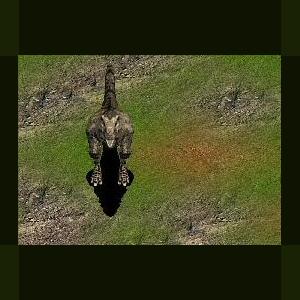About This File
Daspletosaurus is closely related to the much larger and more recent Tyrannosaurus. Like most known tyrannosaurids, it was a multi-ton bipedal predator equipped with dozens of large, sharp teeth. Daspletosaurus had the small forelimbs typical of tyrannosaurids, although they were proportionately longer than in other genera.
As an apex predator, Daspletosaurus was at the top of the food chain, probably preying on large dinosaurs like the ceratopsid Centrosaurus and the hadrosaur Hypacrosaurus. In some areas, Daspletosaurus coexisted with another tyrannosaurid, Gorgosaurus, though there is some evidence of niche differentiation between the two. While Daspletosaurus fossils are rarer than other tyrannosaurids, the available specimens allow some analysis of the biology of these animals, including social behavior, diet and life history.
While very large by the standard of modern predators, Daspletosaurus was not the largest tyrannosaurid. Adults could reach a length of 8–9 meters (26–30 ft) from snout to tail. Mass estimates have centered around 2.5 tonnes (2.75 short tons)but have ranged between 1.8 tonnes (2 tons)and 3.8 tonnes (4.1 tons).
Life restoration of Daspletosaurus. Daspletosaurus had a massive skull that could reach more than 1 meter (3.3 ft) in length. The bones were heavily constructed and some, including the nasal bones on top of the snout, were fused for strength. Large fenestrae (openings) in the skull reduced its weight. An adult Daspletosaurus was armed with about six dozen teeth that were very long but oval in cross section rather than blade-like. Unlike its other teeth, those in the premaxilla at the end of the upper jaw had a D-shaped cross section, an example of heterodonty always seen in tyrannosaurids. Unique skull features included the rough outer surface of the maxilla (upper jaw bone) and the pronounced crests around the eyes on the lacrimal, postorbital, and jugal bones. The orbit (eye socket) was a tall oval, somewhere in between the circular shape seen in Gorgosaurus and the 'keyhole' shape of Tyrannosaurus.
Daspletosaurus shared the same body form as other tyrannosaurids, with a short, S-shaped neck supporting the massive skull. It walked on its two thick hindlimbs, which ended in four-toed feet, although the first digit (the hallux) did not contact the ground. In contrast, the forelimbs were extremely small and bore only two digits, although Daspletosaurus had the longest forelimbs in proportion to body size of any tyrannosaurid. A long, heavy tail served as a counterweight to the head and torso, with the center of gravity over the hips.



Recommended Comments
There are no comments to display.
Create an account or sign in to comment
You need to be a member in order to leave a comment
Create an account
Sign up for a new account in our community. It's easy!
Register a new accountSign in
Already have an account? Sign in here.
Sign In Now